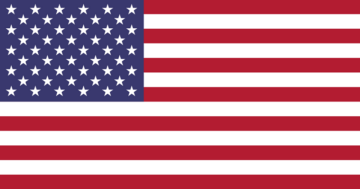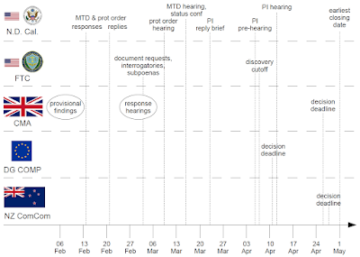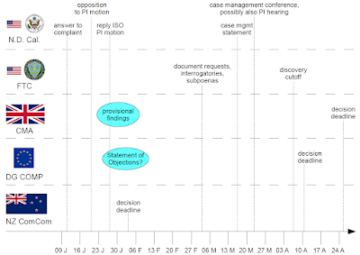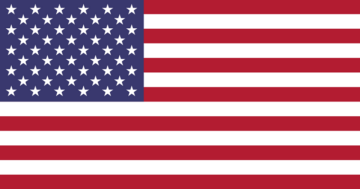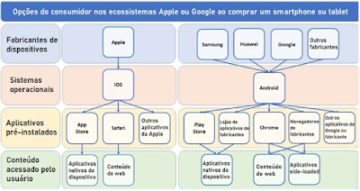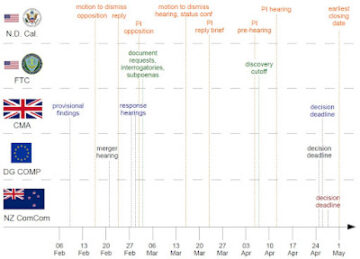Patent pool administrator Sisvel just announced that Huawei, one of the largest patent holders in this space, has joined the narrowband Internet of Things (IoT) patent pool that was launched last November. The largest founding licensor was Ericsson.
This is the second Sisvel pool for Huawei to join. More than a year ago, Huawei started its working relationship with Sisvel as an initial licensor of its WiFi 6 pool (as Sisvel president Mattia Fogliacco recalls in today’s press release) and is also an Avanci 5G licensor, which shows that the Chinese innovator is increasingly receptive to pool-based licensing solutions. Other major SEP holders may now be more interested in joining this pool, given that Huawei and Ericsson (as well as various other patent holders) already give the licensing program a lot of substance.
Sisvel’s updated list of NB-IoT licensors contains several other names I haven’t previously noticed, such as KPN, Deutsche Telekom, and BlackBerry. What licensees get is a “one-stop shop” (as Sisvel’s cellular IoT program manager Sven Torringer calls it in today’s press release) that gives them access to more than two dozen patent portfolios, with Huawei, Ericsson, and NTT Docomo being considered particularly strong in narrowband IoT. It’s fair to say that Huawei had a leadership role in the development of the IoT-related parts of the 4G/LTE standard.
Sisvel’s press release mentions “new royalty rates for the Cellular IoT patent pool, including for devices with a lower selling price,” and that it has “expanded its offering to new product verticals.” Previously, as I reported at the time, the rate was “$0.66 per unit for LTE-M” and “a distinction [was] made between asset trackers ($1.33 per unit) and smart meters ($2 per unit).” The $2 (smart meters) and $1.33 (smart sensors with a selling price above $20 and up to $130) price points are still found. But now there is also a $0.35 per-unit royalty rate for smart sensors with a selling price above $6 (up to $20) and a $0.08 per-unit rate for devices with a selling price of $6 or less.
For makers of low-priced IoT products, this means the value proposition has changed enormously in their favor: far more patents, and far lower rates for certain applications. It looks like two factors have resulted in this more flexible and attractive royalty structure:
-
In my commentary on the creation of the pool I already noted that the challenge for an IoT patent pool is market development: it’s not enough to offer licenses or to dissuade implementer from infringement, but about adoption of the standard. Patent pool administrators operate in a two-sided market. They have to bring licensors and licensees together, and in order to do so, they have to listen to both sides.
-
Sisvel’s new NB-IoT royalty rates are definitely reconcilable with Huawei’s bilateral licensing terms for such products, which are highly differentiated as I explained last month. The pool is a one-stop option, but it’s not the only way to get access to Huawei’s intellectual property.
Huawei is both a major patent holder and a large-scale implementer. If a pool worked for only one side, Huawei would find it hard or even impossible to join.
The rock-bottom rates that the pool now offers for devices with a selling price of $6 or less should enable new applications. What comes to mind as potentially the highest-volume and lowest-price NB-IoT application is called printable NB-IoT tracking labels. They are asset trackers in the form of stickers that could, for instance, track an Amazon package.
At a time when policy makers are working on an EU SEP Regulation, it’s warranted to put major SEP news such as this one into the current political context. The European Commission’s Directorate-General for the Internal Market (DG GROW) clearly underestimated the extent to which patent pools could be part of the solution as opposed to being part of the problem. The favorite pretext (not only of DG GROW but also Apple and its allies and astroturfers) to push for legislative intervention is that IoT SMEs allegedly need a different legal environment. But patent holders are smart enough to realize that IoT patent licensing won’t work unless the royalty rates enable IoT product makers to thrive. While I still haven’t seen a single SEP enforcement action against an SME as defined by the EU, and the IoT sector is generally not a legal battlefield at the moment, the market continues to find and improve solutions.
Patent pools not only bring licensors together with licensees, but also have to broker a compromise between licensors of very different kinds. Huawei with its high product volume (which is not fully visible to people in the Western hemisphere for purely geopolitical reasons, but is a reality in the rest of the world) obviously has a more balanced take than a non-practicing entity, which is not meant to disparage NPEs but plainly a fact. In order for a pool to unite product makers like Huawei and Ericsson with infrastructure companies like NTT Docomo and Deutsche Telekom as well as with research institutes and patent licensing firms, it has to identify royalty rates that work for all of them.
An EUIPO-led process for aggregate (entire standard) and bilateral (licensor A and licensee B) royalty determinations will cause delay and complicate matters. In the meantime, patent pool administrators and other market actors work out and fine-tune the solutions they offer.
With so much in flux especially concerning IoT, the prudent thing for the EU to do would be to wait and better understand what’s going on. Instead of trying to adopt something before the end of the legislative term just for the sake of having some kind of outcome to show (no matter how flawed), they should go back to the drawing board and take note of new developments, such as IoT licensing terms becoming more attractive at a breathtaking pace.
- SEO Powered Content & PR Distribution. Get Amplified Today.
- PlatoData.Network Vertical Generative Ai. Empower Yourself. Access Here.
- PlatoAiStream. Web3 Intelligence. Knowledge Amplified. Access Here.
- PlatoESG. Carbon, CleanTech, Energy, Environment, Solar, Waste Management. Access Here.
- PlatoHealth. Biotech and Clinical Trials Intelligence. Access Here.
- Source: http://www.fosspatents.com/2023/09/sisvels-narrowband-iot-patent-pool.html
- :has
- :is
- :not
- $UP
- 08
- 33
- 35%
- 5G
- 6
- 66
- a
- About
- above
- access
- Action
- actors
- administrators
- adopt
- Adoption
- against
- aggregate
- ago
- All
- allegedly
- already
- also
- Amazon
- an
- and
- Apple
- Application
- applications
- ARE
- AS
- asset
- At
- attractive
- b
- back
- balanced
- Battlefield
- BE
- becoming
- before
- begin
- being
- Better
- between
- bilateral
- board
- boosts
- both
- Both Sides
- breathtaking
- bring
- Bringing
- broker
- but
- button
- by
- called
- Calls
- Cause
- cellular
- certain
- challenge
- changed
- chinese
- clear
- clearly
- comes
- commission
- Companies
- compromise
- concerning
- considered
- contains
- context
- continues
- could
- creation
- Current
- defined
- definitely
- delay
- DEUTSCHE TELEKOM
- Development
- developments
- Devices
- different
- differentiated
- disparage
- dissuade
- distinction
- do
- DOCOMO
- dozen
- drawing
- enable
- end
- enforcement
- enormously
- enough
- Entire
- entity
- Environment
- Ericsson
- Ether (ETH)
- EU
- European
- european commission
- Even
- expanded
- explained
- extent
- fact
- factors
- fair
- far
- favor
- Favorite
- Find
- firms
- flawed
- flexible
- FLUX
- For
- form
- found
- founding
- from
- fully
- generally
- geopolitical
- get
- Give
- given
- gives
- Go
- going
- Grow
- had
- Hard
- Have
- haven
- having
- High
- holder
- holders
- How
- HTML
- http
- HTTPS
- Huawei
- i
- identify
- if
- impossible
- improve
- in
- Including
- increasingly
- Infrastructure
- infringement
- initial
- Innovator
- instance
- instead
- intellectual
- intellectual property
- interested
- internal
- Internet
- internet of things
- intervention
- into
- iot
- IT
- ITS
- join
- joined
- joining
- just
- Kind
- kinds
- large-scale
- largest
- Last
- Leadership
- Legal
- Legislative
- less
- licensees
- licenses
- Licensing
- like
- List
- listen
- LOOKS
- Lot
- lower
- made
- major
- Makers
- manager
- many
- Market
- Matter
- Matters
- May..
- means
- meant
- meantime
- mentions
- mind
- moment
- more
- much
- my
- names
- Need
- New
- new product
- news
- no
- note
- noted
- noticed
- now
- NTT
- NTT DOCOMO
- of
- offer
- offering
- Offers
- on
- ONE
- only
- operate
- opposed
- Option
- or
- order
- Other
- Others
- out
- Outcome
- Pace
- package
- part
- particularly
- parts
- patent
- Patents
- People
- per
- PHP
- plato
- Plato Data Intelligence
- PlatoData
- points
- policy
- Policy Makers
- political
- pool
- Pools
- portfolios
- potentially
- president
- press
- Press Release
- previously
- price
- Problem
- process
- Product
- Products
- Program
- property
- proposition
- purely
- Push
- put
- Rate
- Rates
- Reality
- realize
- reasons
- Regulation
- relationship
- release
- Reported
- research
- REST
- resulted
- Role
- royalty
- s
- sake
- say
- Second
- sector
- seen
- Selling
- sensors
- several
- Shop
- should
- show
- Shows
- side
- Sides
- single
- smart
- SME
- SMEs
- So
- solution
- Solutions
- some
- something
- Space
- standard
- started
- stickers
- Still
- strong
- structure
- substance
- such
- T
- Take
- term
- terms
- than
- that
- The
- the world
- their
- Them
- There.
- they
- thing
- things
- this
- Thrive
- time
- to
- today
- together
- track
- Trackers
- Tracking
- trying
- two
- understand
- unit
- unite
- unless
- value
- various
- verticals
- very
- visible
- volume
- wait
- was
- Way..
- WELL
- Western
- What
- when
- which
- while
- will
- with
- Won
- Work
- work out
- worked
- working
- world
- would
- year
- zephyrnet



